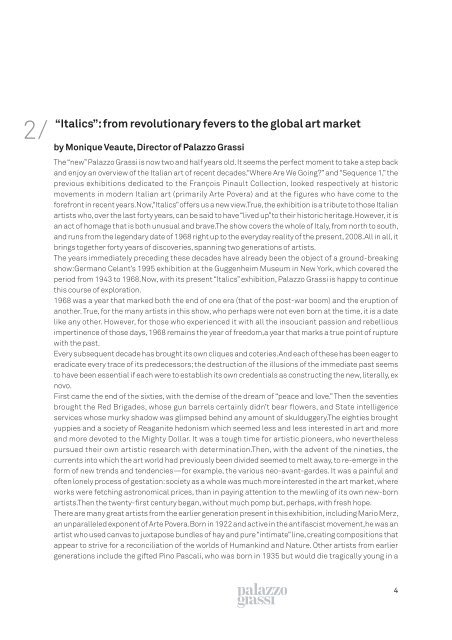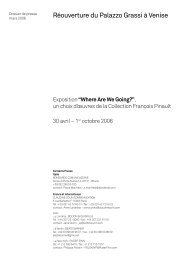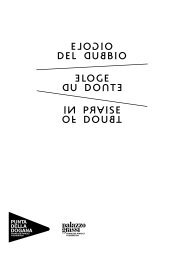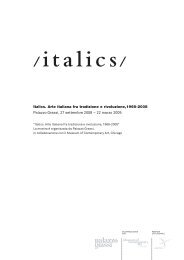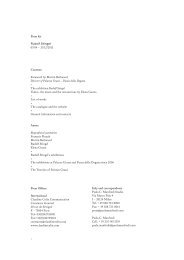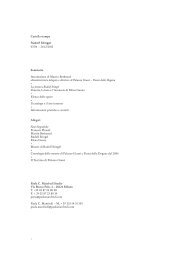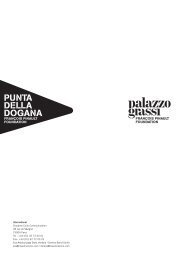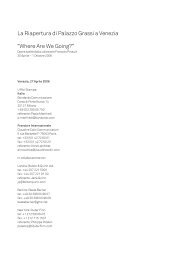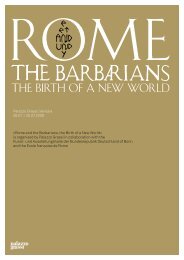pdf file, 1,19 Mb - Palazzo Grassi
pdf file, 1,19 Mb - Palazzo Grassi
pdf file, 1,19 Mb - Palazzo Grassi
You also want an ePaper? Increase the reach of your titles
YUMPU automatically turns print PDFs into web optimized ePapers that Google loves.
2/<br />
“Italics”: from revolutionary fevers to the global art market<br />
by Monique Veaute, Director of <strong>Palazzo</strong> <strong>Grassi</strong><br />
The “new” <strong>Palazzo</strong> <strong>Grassi</strong> is now two and half years old. It seems the perfect moment to take a step back<br />
and enjoy an overview of the Italian art of recent decades.“Where Are We Going?” and “Sequence 1,” the<br />
previous exhibitions dedicated to the François Pinault Collection, looked respectively at historic<br />
movements in modern Italian art (primarily Arte Povera) and at the figures who have come to the<br />
forefront in recent years.Now,“Italics” offers us a new view.True, the exhibition is a tribute to those Italian<br />
artists who, over the last forty years, can be said to have “lived up”to their historic heritage.However, it is<br />
an act of homage that is both unusual and brave.The show covers the whole of Italy, from north to south,<br />
and runs from the legendary date of <strong>19</strong>68 right up to the everyday reality of the present, 2008.All in all, it<br />
brings together forty years of discoveries, spanning two generations of artists.<br />
The years immediately preceding these decades have already been the object of a ground-breaking<br />
show:Germano Celant’s <strong>19</strong>95 exhibition at the Guggenheim Museum in New York, which covered the<br />
period from <strong>19</strong>43 to <strong>19</strong>68.Now, with its present “Italics” exhibition, <strong>Palazzo</strong> <strong>Grassi</strong> is happy to continue<br />
this course of exploration.<br />
<strong>19</strong>68 was a year that marked both the end of one era (that of the post-war boom) and the eruption of<br />
another. True, for the many artists in this show, who perhaps were not even born at the time, it is a date<br />
like any other. However, for those who experienced it with all the insouciant passion and rebellious<br />
impertinence of those days, <strong>19</strong>68 remains the year of freedom,a year that marks a true point of rupture<br />
with the past.<br />
Every subsequent decade has brought its own cliques and coteries.And each of these has been eager to<br />
eradicate every trace of its predecessors; the destruction of the illusions of the immediate past seems<br />
to have been essential if each were to establish its own credentials as constructing the new, literally, ex<br />
novo.<br />
First came the end of the sixties, with the demise of the dream of “peace and love.” Then the seventies<br />
brought the Red Brigades, whose gun barrels certainly didn’t bear flowers, and State intelligence<br />
services whose murky shadow was glimpsed behind any amount of skulduggery.The eighties brought<br />
yuppies and a society of Reaganite hedonism which seemed less and less interested in art and more<br />
and more devoted to the Mighty Dollar. It was a tough time for artistic pioneers, who nevertheless<br />
pursued their own artistic research with determination.Then, with the advent of the nineties, the<br />
currents into which the art world had previously been divided seemed to melt away, to re-emerge in the<br />
form of new trends and tendencies—for example, the various neo-avant-gardes. It was a painful and<br />
often lonely process of gestation: society as a whole was much more interested in the art market, where<br />
works were fetching astronomical prices, than in paying attention to the mewling of its own new-born<br />
artists.Then the twenty-first century began, without much pomp but, perhaps, with fresh hope.<br />
There are many great artists from the earlier generation present in this exhibition, including Mario Merz,<br />
an unparalleled exponent of Arte Povera.Born in <strong>19</strong>22 and active in the antifascist movement,he was an<br />
artist who used canvas to juxtapose bundles of hay and pure “intimate” line, creating compositions that<br />
appear to strive for a reconciliation of the worlds of Humankind and Nature. Other artists from earlier<br />
generations include the gifted Pino Pascali, who was born in <strong>19</strong>35 but would die tragically young in a<br />
4


